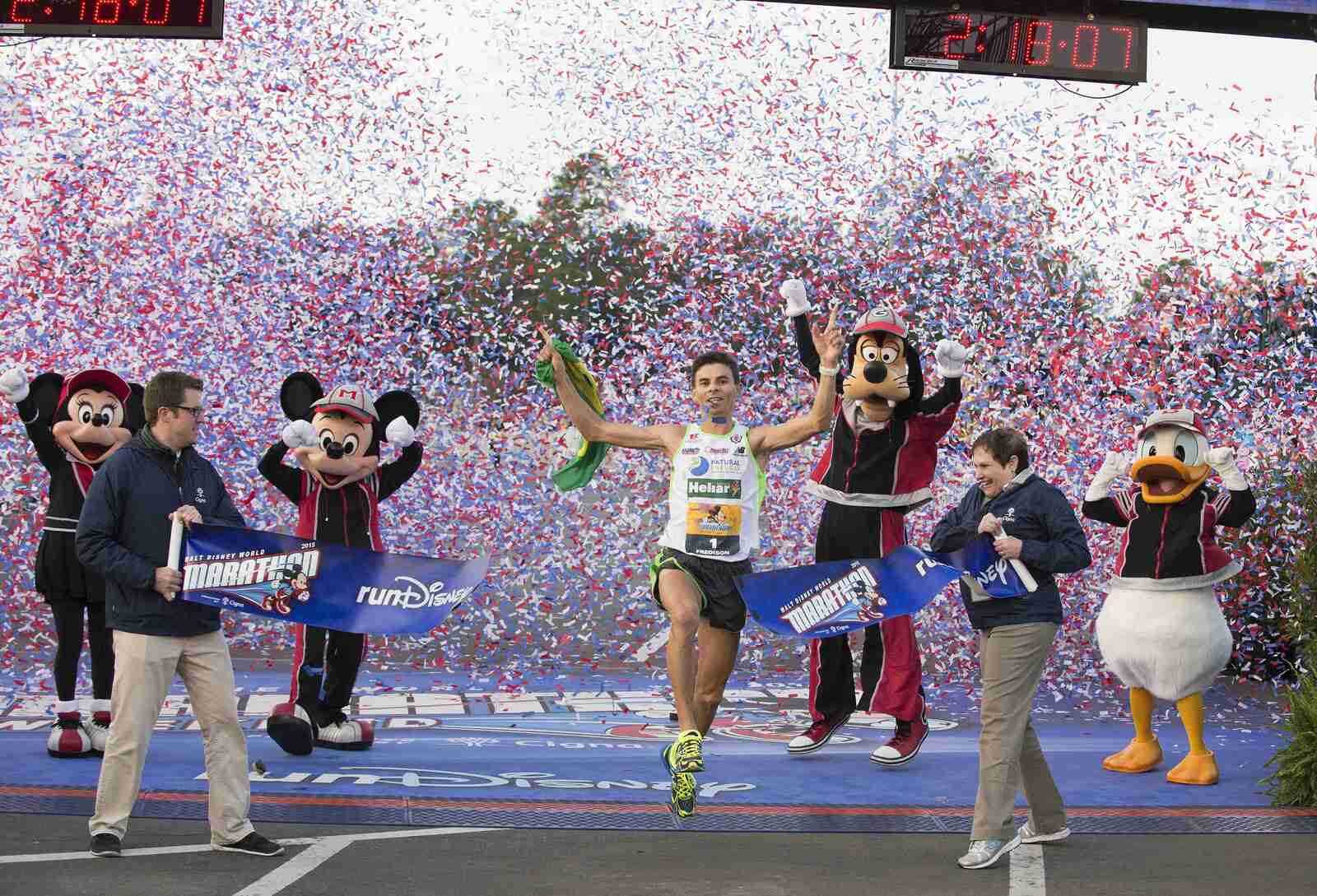

Featured
How To Train For A Half Marathon
Modified: January 22, 2024
Learn the best training strategies and techniques for running a half marathon. Discover our featured tips and advice to help you prepare for the race.
Introduction
Training for a half marathon is an exciting and challenging endeavor. Whether you are a seasoned runner looking to push your limits or a beginner ready to take on the next fitness milestone, proper training is crucial to ensure a successful and enjoyable race. In this article, we will guide you through the essential steps to train for a half marathon, from setting goals to race day strategies.
Running a half marathon, which is 13.1 miles or 21 kilometers in distance, requires dedication, discipline, and a structured training plan. It is important to approach your training with a positive mindset and a commitment to putting in the necessary time and effort. By following a well-designed training program, you can gradually build your endurance, improve your speed, and reduce the risk of injury.
Before diving into the specifics of training, it is essential to assess your current fitness level and set realistic goals. Are you looking to simply complete the race or aim for a specific time? Understanding your objectives will help shape your training plan and provide motivation throughout the process.
As you embark on your half marathon preparation, it’s important to remember that consistency is key. Gradually increase your mileage, incorporate variety in your workouts, and listen to your body. Pushing yourself too hard or neglecting rest and recovery can lead to overuse injuries and hinder your progress.
In the coming sections, we will delve into the details of training for a half marathon, covering everything from choosing the right plan, incorporating proper warm-up and stretching routines, to endurance and speed workouts. We will also touch on crucial factors such as nutrition, injury prevention, and mental preparation. By the end of this article, you will be equipped with the knowledge and tools to take on your half marathon with confidence.
Setting Goals
Setting goals is an important first step in your half marathon training journey. Having clear and realistic goals will keep you motivated and focused throughout the training process. When setting your goals, consider both your current fitness level and your long-term aspirations.
Start by determining your primary goal for the race. Are you aiming to simply finish the half marathon, or do you have a specific time in mind? It’s important to set a goal that is challenging yet attainable for your current fitness level. Keep in mind that it’s okay to adjust your goals as you progress in your training.
In addition to your primary goal, consider setting secondary goals that can provide additional motivation and benchmarks along the way. These goals can be related to speed, endurance, or even mental focus. For example, you might aim to run a certain distance without stopping, complete a long run at a faster pace, or improve your overall running form.
Remember to make your goals specific, measurable, achievable, relevant, and time-bound (SMART goals). Instead of saying, “I want to finish the half marathon,” a more specific goal would be, “I want to complete the half marathon in under two hours.” Setting clear goals allows you to track your progress and make adjustments as needed.
Consider sharing your goals with others. Whether it’s your running buddy, a supportive friend, or on social media, sharing your goals publicly can help keep you accountable and provide a support system throughout your training journey.
Lastly, be open to adjusting your goals if needed. As you progress in your training, you may find that you are capable of more than you initially thought. On the flip side, unforeseen circumstances or injuries may require you to readjust your goals. Be flexible and remember that the most important thing is to enjoy the process and cross the finish line strong.
Setting goals is an important aspect of half marathon training. By having clear objectives in mind, you can tailor your training plan to suit your needs and stay motivated throughout the process. Now that you have set your goals, it’s time to dive into the details of your training schedule.
Training Schedule
Having a well-structured training schedule is essential for successfully preparing for a half marathon. A training schedule helps you stay organized, ensures proper progression, and allows you to track your progress as you build up your endurance and fitness levels.
The duration of your training schedule will depend on your current fitness level and your target race date. Most training plans range from 12 to 16 weeks, but it can vary based on individual needs and preferences. It’s important to give yourself ample time to build up your mileage gradually and avoid overtraining.
When creating your training schedule, consider the number of days per week you can dedicate to running and cross-training. A typical half marathon training plan includes three to four days of running, with one to two days of cross-training or rest. It’s important to strike a balance between running and allowing your body to recover.
Plan your long runs for the weekends when you have more time and energy. The long run is a key component of your training as it helps build endurance and prepares your body for the distance of the half marathon. Start with a comfortable distance and gradually increase it each week, with a step-back week every few weeks to allow for recovery.
Incorporate speed workouts into your training schedule to improve your overall pace and running efficiency. These can include tempo runs, intervals, or fartlek training. Speed workouts should be challenging but not overly strenuous. Be sure to warm up properly before starting these workouts and allow for adequate recovery between intervals.
Cross-training activities, such as cycling, swimming, or strength training, can be included in your training schedule to provide variety and help prevent overuse injuries. These activities can also improve your overall fitness and complement your running training.
Rest days are just as important as the training days. They give your body time to recover, repair, and adapt to the training load. Avoid the temptation to skip rest days or add extra workouts. Remember, rest is an integral part of the training process and helps prevent burnout and injuries.
As you progress through your training, be flexible with your schedule. Life happens, and unexpected events may require you to modify your plan. It’s okay to shuffle your training days or adjust your mileage as long as you maintain the overall structure of your plan.
By following a well-designed training schedule, you will improve your running performance, reduce the risk of injuries, and be well-prepared for race day. In the next section, we will discuss how to choose the right training plan for your needs.
Choosing the Right Plan
Choosing the right training plan is crucial for your half marathon journey. There are various plans available, each tailored to different fitness levels and goals. Selecting a plan that aligns with your needs and abilities will provide you with the necessary structure and guidance to reach your goals.
When choosing a training plan, consider your current fitness level and running experience. If you are a beginner, look for plans designed specifically for novice runners. These plans typically have a gradual progression of mileage and focus on building endurance and confidence. Intermediate or advanced runners may opt for plans that include more speed workouts and higher mileage to challenge their performance.
Take into account the time commitment required by each plan. Some plans may require more training days per week or longer workout sessions. Assess your schedule and choose a plan that fits realistically into your daily routine. It’s important to strike a balance between your running training and other responsibilities to avoid burnout.
Consider your goals when selecting a plan. Are you aiming for a specific time goal? Do you want to focus on running stronger or improving your endurance? Look for plans that align with your goals and include the necessary components to help you achieve them. Plans that incorporate speed workouts, long runs, and recovery days are essential for a well-rounded training experience.
Read reviews and testimonials from other runners who have followed the plan you are considering. Look for feedback on the plan’s effectiveness, clarity, and suitability for different fitness levels. Personal recommendations from experienced runners or trainers can also be valuable in your decision-making process.
Be realistic about your abilities and limitations. If a plan feels too overwhelming or intimidating, it may not be the right fit for you. Listen to your body and choose a plan that allows room for adjustments and modifications as needed. Flexibility is key to successful training.
Remember that no training plan is perfect, and you may need to make adjustments along the way. Adapt the plan to your individual needs and circumstances. If the plan calls for a rest day but you feel energized and eager to run, it’s okay to swap rest days or add an extra workout. Trust your instincts while keeping your overall training goals in mind.
By choosing the right training plan, you will set yourself up for a successful and enjoyable half marathon journey. The plan will provide you with structure, guidance, and the necessary tools to reach your goals. In the next section, we will discuss the importance of warm-up and stretching in your training routine.
Warm-Up and Stretching
Warm-up and stretching are essential components of your half marathon training routine. They help prepare your body for the physical demands of running, reduce the risk of injury, and enhance your overall performance. Incorporating proper warm-up and stretching techniques into your training schedule will contribute to a successful and enjoyable race day.
Before starting any workout or run, it is important to warm up your body. A proper warm-up increases your heart rate, raises your body temperature, and prepares your muscles for the upcoming physical activity. Aim to spend around 5-10 minutes performing a dynamic warm-up routine that includes movements such as walking, jogging, lunges, high knees, and arm swings.
The dynamic warm-up should be specific to running and mimic the movements you will be performing during your run. This helps to activate and engage the muscles, increase blood flow, and improve flexibility. Gradually progress from slower to faster movements, allowing your body to adjust and reduce the risk of strain or injury.
After your warm-up, it is important to incorporate stretching into your routine. Stretching helps to improve flexibility, elongate the muscles, and prevent muscle imbalances. Focus on dynamic stretching, which involves controlled movements through a full range of motion.
Dynamic stretches such as leg swings, walking lunges, and hip circles can be done to further warm up the specific muscles used in running. Avoid static stretches, where you hold a position for an extended period, before your run. Static stretching is best saved for post-run when your muscles are warm and more receptive to stretching.
Stretching after your run is equally important for recovery and injury prevention. Aim to hold each static stretch for 15-30 seconds, focusing on major muscle groups like the calves, quadriceps, hamstrings, and hips. Remember to breathe deeply and relax into each stretch, avoiding any bouncing or jerky movements.
Incorporating foam rolling into your stretching routine can also help release muscle tension and improve flexibility. Foam rolling targets trigger points and knots in the muscles, helping to decrease muscle tightness and increase mobility. Roll slowly and deliberately over the desired muscles, and adjust the pressure based on your comfort level.
Keep in mind that warm-up and stretching routines may vary depending on your personal needs and preferences. It’s essential to find a routine that works best for you. Experiment with different exercises and stretches to find what feels most comfortable and beneficial for your body.
By implementing a proper warm-up and stretching routine, you are priming your body for the physical demands of running and reducing the risk of injury. In the next section, we will discuss the importance of maintaining proper running form to optimize your performance.
Proper Running Form
Proper running form is essential for efficient and injury-free running. It involves maintaining good posture, utilizing proper arm movement, and maintaining a consistent stride. Developing and maintaining proper running form can significantly enhance your performance and help you achieve your goals in a half marathon.
One of the fundamental elements of proper running form is posture. Keep your head up, eyes forward, and shoulders relaxed. Avoid slouching or leaning forward too much, as this can strain your neck, shoulders, and back. Instead, imagine a straight line from your head to your ankles, with your body upright and aligned.
Proper arm movement is another crucial component of running form. Your arms should be relaxed, slightly bent at the elbows, and move back and forth naturally, following the forward motion of your legs. Avoid unnecessary arm swinging, crossing your arms across your body, or excessive movement that can waste energy.
Focus on maintaining a consistent stride length and rate. Stride length refers to the distance covered with each step, while stride rate refers to the number of steps you take per minute. Aim for a stride length that feels comfortable and efficient, and a stride rate that allows for quick turnover without overstriding or excessively shortening your steps.
Always land on your midfoot or forefoot when running, rather than striking the ground with your heel. Landing on your midfoot or forefoot helps absorb the impact and promotes a more efficient push-off. Strive for a smooth and quiet foot strike, avoiding heavy pounding or excessive noise when your foot hits the ground.
Breathe rhythmically and deeply while maintaining your running form. Aim for a comfortable and consistent breathing pattern that matches your running pace. This will help deliver oxygen to your working muscles and optimize your performance.
Video analysis or guidance from a running coach can be immensely helpful in evaluating and improving your running form. They can provide feedback on specific adjustments you can make to optimize your efficiency and reduce the risk of injuries.
It’s important to remember that proper running form may take time to develop and master. Be patient with yourself and focus on one aspect of form at a time, gradually incorporating changes into your running routine. Practice regularly and listen to your body as you strive to improve your running form.
By maintaining proper running form, you can optimize your efficiency, reduce the risk of injuries, and improve your overall performance in a half marathon. In the next section, we will discuss the importance of endurance training in your half marathon preparation.
Endurance Training
Endurance training is a vital component of half marathon preparation. Building your endurance allows you to cover the required distance comfortably and sustain a steady pace throughout the race. By incorporating specific workouts and gradually increasing your mileage, you can improve your cardiovascular fitness and enhance your endurance capabilities.
A key aspect of endurance training is the long run. The long run is typically done once a week and gradually increases in duration as you progress through your training. It helps develop your aerobic capacity, build mental resilience, and prepares your body for the demands of running a half marathon.
When starting your long runs, focus on covering the distance rather than worrying about the pace. Begin with a distance that feels manageable and gradually increase it each week, incorporating step-back weeks to allow your body to recover. The long run should be done at a relaxed conversational pace, where you can comfortably maintain a conversation while running.
In addition to the long run, incorporate tempo runs into your training. Tempo runs involve sustained efforts at a comfortably hard pace, just below your lactate threshold. These workouts help improve your ability to sustain a faster pace over a prolonged period by increasing your lactate threshold and efficiency.
Interval training is another effective way to boost your endurance. Intervals involve running at a higher intensity for a set distance or time, followed by a period of recovery. This alternating pattern helps improve your cardiovascular system, increase your aerobic capacity, and enhance your ability to maintain a faster pace.
As you progress through your endurance training, consider incorporating progression runs. These workouts involve starting at an easy pace and gradually increasing your speed throughout the run. Progression runs mimic the natural build-up of effort during a race and help train your body to handle the intensity and challenges of the half marathon distance.
Be consistent with your endurance training. Gradually increase your mileage and intensity over time, allowing your body to adapt to the demands of running and building your endurance gradually. Listen to your body and adjust your training as needed to prevent overuse injuries and maintain your overall well-being.
Maintaining a balance between endurance training, rest days, and cross-training is crucial. Cross-training activities such as swimming, cycling, or strength training can help improve overall fitness, prevent overuse injuries, and give your running muscles a break while still maintaining cardiovascular fitness.
By incorporating endurance training into your half marathon preparation, you will improve your ability to cover the distance comfortably and sustain a steady pace on race day. In the next section, we will discuss the importance of speed workouts in your training routine.
Speed Workouts
Speed workouts are a crucial component of half marathon training that can help you improve your pace, increase your overall running efficiency, and challenge yourself to reach new levels of performance. Incorporating specific speed workouts into your training routine can provide a variety of benefits and help you achieve your race day goals.
One of the most common types of speed workouts is interval training. Intervals involve alternating periods of high-intensity effort with periods of recovery. For example, you might run at a fast pace for a specific distance or time, followed by a period of jogging or walking to recover. This type of training helps improve your anaerobic threshold, increase your running speed, and build mental resilience.
Another effective speed workout is tempo runs. Tempo runs involve running at a comfortably hard pace just below your lactate threshold. This pace should feel challenging, but still allow you to maintain a consistent effort. Tempo runs help improve your ability to sustain a faster pace for longer periods, increase your lactate threshold, and challenge your aerobic capacity.
Fartlek training is a fun and unstructured form of speed workout that involves incorporating faster bursts of running into your regular run. During a fartlek, you can choose landmarks such as trees, lamp posts, or street signs to increase your speed for a short distance before returning to your regular pace. Fartlek training helps improve your speed, cardiovascular fitness, and mental agility as you adapt to changing intensities.
When performing speed workouts, it is crucial to warm up properly and cool down afterward to prevent injuries. Start your speed workout with a dynamic warm-up routine to activate your muscles and prepare your body for the increased intensity. After the workout, allow time for a gentle cooldown jog and perform static stretches to promote flexibility and aid in recovery.
It is essential to listen to your body during speed workouts and adjust the intensity based on your fitness level and current abilities. Start with shorter intervals or slower tempos if you are new to speed workouts, gradually increasing the duration and intensity as you progress. Always prioritize good form and maintain proper running mechanics to avoid unnecessary strain or injury.
Variety is key when it comes to speed workouts. Incorporate different types of intervals, tempos, and fartleks into your training plan to challenge different energy systems, improve overall speed, and keep your workouts interesting. This variety will also help prevent plateauing and keep you engaged and motivated throughout your training.
Remember to include adequate rest and recovery days between speed workouts to allow your muscles to repair and adapt to the increased stress. Striking a balance between challenging your body and allowing it time to recover is critical for optimizing your performance during training.
By incorporating speed workouts into your half marathon training, you will improve your running speed, increase your anaerobic threshold, and enhance your overall race day performance. In the next section, we will discuss the importance of hill training for half marathon success.
Hill Training
Hill training is a valuable component of half marathon preparation that can help improve your strength, stamina, and overall running performance. Incorporating hill workouts into your training routine will challenge your muscles in unique ways, build mental resilience, and prepare you to conquer inclines on race day.
Running uphill engages different muscle groups, such as your glutes, hamstrings, and calves, more intensely than running on flat terrain. This increased muscle activation helps improve power, speed, and overall running efficiency. Hill training also increases your cardiovascular endurance, allowing you to maintain a steady pace even when faced with hilly sections of the race course.
When incorporating hill workouts into your training, start with shorter hill repeats and gradually increase the duration and intensity as you progress. Find a hill with a moderate incline on a safe and well-lit route. Begin by running up the hill at a moderate effort, focusing on maintaining good form and a consistent stride. Jog or walk back down the hill to recover before tackling the next repeat.
Focus on maintaining proper running form while running uphill. Keep your posture upright, engage your core, and use your arms for balance and momentum. Take shorter, quicker steps to maintain your rhythm and avoid overstriding. Breath deeply and find a cadence that allows you to maintain a steady effort throughout the ascent.
Incorporating downhill running into your hill training is just as important. Downhill running strengthens different muscle groups, particularly those involved in eccentric contractions. This type of training improves your ability to control your speed and reduce the risk of injury during downhill portions of the race.
When running downhill, focus on maintaining a controlled descent to minimize impact and reduce the risk of jarring your joints. Lean slightly forward and let gravity work with you, but avoid leaning back or braking too much. Take slightly longer strides and allow your body to naturally pick up speed, while still maintaining control.
As with any intense training, it is important to listen to your body and adjust the intensity and duration of your hill workouts as necessary. Avoid overexertion or extreme fatigue that may lead to injury. Be mindful of any existing health conditions or previous injuries that may be exacerbated by hill training, and consult with a healthcare professional if needed.
Include hill workouts in your training schedule once or twice a week, depending on your fitness level and goals. Gradually increase the number of hill repeats or the distance covered on hills as you progress through your training. Be consistent and patient, allowing your body to adapt to the added challenges of running uphill.
Hill training not only improves your physical strength and endurance but also enhances your mental toughness and ability to overcome challenging race conditions. By incorporating hill workouts into your half marathon training, you will be well-prepared to conquer any hills you encounter on race day. In the next section, we will discuss the importance of long runs in your training routine.
Long Runs
Long runs are a critical component of half marathon training that help build endurance, mental resilience, and confidence for race day. These runs are typically done once a week and gradually increase in distance to prepare your body for the 13.1-mile challenge.
The primary purpose of long runs is to teach your body to sustain effort over an extended period. By gradually increasing the distance each week, you incrementally build your aerobic capacity, improve your running economy, and strengthen your mental stamina. Long runs also provide an opportunity to practice race day nutrition, pacing, and mental strategies.
The distance of your long runs will depend on your fitness level and race goals. Start with a comfortable distance that you can complete without excessive strain or exhaustion. Each week, progressively add 1-2 miles to your long run, with occasional step-back weeks to allow for recovery.
When embarking on a long run, pace yourself conservatively. The purpose of a long run is to cover the distance, not to achieve your fastest pace. Start at a comfortable, conversational pace and focus on maintaining a steady rhythm. Gradually increase your effort in the later stages of the run, if desired, to simulate the fatigue you may experience during the later miles of the race.
Hydration and nutrition play a crucial role during long runs, as they replicate race day conditions. Plan your hydration strategy by carrying water with you or strategically placing water stations along your route. Practice fueling with gels, energy bars, or other easily digestible snacks to understand what works best for your body.
Mentally, long runs can be challenging. Break the distance into smaller segments or milestones to make it more manageable. Focus on staying present and using positive affirmations or visualization techniques to keep your motivation high. Running with a buddy or joining a group can provide additional support and make the long runs more enjoyable.
Pay attention to your body during long runs and adjust your training as needed. If you experience excessive fatigue, pain, or discomfort, it may be a sign to ease off or modify your training. It’s essential to strike a balance between pushing your limits and avoiding overtraining or injury.
Remember, long runs are a gradual progression. Don’t get discouraged if some runs feel more challenging than others. Persevere, trust the training process, and celebrate the incremental improvements you make along the way.
Long runs are an integral part of half marathon training that build physical and mental endurance. Through consistent and progressive long run training, you will develop the confidence and stamina needed to conquer the distance on race day. In the next section, we will explore the benefits of cross-training in your training routine.
Cross-Training
Integrating cross-training into your half marathon training routine can have numerous benefits for both your overall fitness and running performance. Cross-training involves engaging in alternative forms of exercise and physical activities that supplement your running training.
One of the key advantages of cross-training is reducing the risk of overuse injuries. Running puts repetitive stress on the same muscles and joints, increasing the likelihood of imbalances and injuries. Cross-training activities, such as swimming, cycling, or strength training, allow you to work different muscle groups, improve overall fitness, and give your running muscles a break while still maintaining cardiovascular conditioning.
Cross-training also allows for active recovery and reduces the impact on your joints. By engaging in low-impact activities like swimming or cycling, you can improve blood circulation, accelerate recovery, and alleviate any soreness or fatigue from your running workouts.
Strength training is particularly valuable for runners as it helps develop muscular strength and endurance, improves running economy, and reduces the risk of running-related injuries. Incorporate exercises that target your lower body, core, and upper body to create a balanced strength training routine.
Yoga and Pilates are excellent cross-training options that focus on flexibility, balance, and body awareness. These practices help increase range of motion, enhance muscular control, and promote better postural alignment. Improved flexibility and body awareness can contribute to better running form and efficiency.
When incorporating cross-training activities into your training routine, consider the following guidelines. Cross-train on your non-running days to allow for proper recovery for your running-specific muscles. Aim for two to three days of cross-training per week, depending on your fitness level and availability.
Choose activities that you enjoy and that complement your running goals. For example, swimming or cycling can help improve cardiovascular fitness and endurance, while strength training can enhance muscular strength and power. Variety is key for overall fitness and to maintain motivation.
Remember to listen to your body and adjust the intensity and duration of cross-training activities as needed. Cross-training should supplement your running training, not replace it. Avoid overexertion or excessively long workouts that may hinder your running performance or lead to fatigue.
By incorporating cross-training into your training routine, you will enhance your overall fitness, reduce the risk of injuries, and improve your running performance. Finding a balance between running-specific training and cross-training activities will support your long-term goals and make you a stronger, more well-rounded runner.
In the next section, we will discuss the importance of rest and recovery in your half marathon training journey.
Rest and Recovery
Rest and recovery are essential components of half marathon training that often go overlooked. While it may be tempting to push yourself to the limit and train non-stop, allowing for proper rest and recovery is vital for optimizing your performance, preventing injuries, and maintaining long-term sustainability.
Rest days are crucial for allowing your body to recover and heal from the stress of training. During rest days, your muscles repair and rebuild, and your energy stores replenish. It’s essential to give yourself regular breaks to prevent overtraining, which can lead to decreased performance, fatigue, and an increased risk of injuries.
Plan for at least one or two rest days each week, where you completely abstain from any form of intense physical activity. Use this time to relax, engage in leisurely activities, and allow your body the opportunity to regenerate.
In addition to rest days, active recovery is also beneficial. Active recovery involves engaging in gentle exercises such as walking, swimming, or yoga, which promote blood flow, enhance muscle recovery, and help alleviate any lingering muscle soreness or stiffness.
Quality sleep is another crucial aspect of recovery. During sleep, your body repairs damaged tissues, releases growth hormones, and enhances brain function. Aim for 7-9 hours of uninterrupted sleep each night to optimize your recovery and performance. Establishing a regular sleep routine and creating a conducive sleep environment can greatly improve the quality of your rest.
Nutrition is also a vital component of rest and recovery. After a hard workout, it’s important to replenish your body with the proper nutrients. Consume a balanced meal or snack that includes carbohydrates for replenishing glycogen stores, protein for muscle repair, and healthy fats and antioxidants to support overall recovery.
Massage, foam rolling, and stretching can aid in muscle recovery and prevent tightness and imbalances. Regularly incorporate these practices into your routine to promote flexibility, improve circulation, and alleviate any muscular tension or discomfort.
Listen to your body and be mindful of any warning signs of overtraining or injuries. If you experience excessive fatigue, persistent pain, or decreased motivation, it may be a sign that you need to incorporate more rest and recovery into your training plan.
Remember that rest and recovery are not signs of weakness, but rather essential components of a successful training program. By allowing your body the time it needs to recover, you will come back stronger, more energized, and ready to tackle your training with renewed vigor.
Incorporating proper rest and recovery into your half marathon training is a key factor in optimizing your performance and preventing injuries. In the next section, we will discuss the importance of nutrition and hydration in supporting your training and race day success.
Nutrition and Hydration
Nutrition and hydration play a crucial role in half marathon training and race day success. Proper fueling and hydration are essential for optimizing your performance, maintaining energy levels, and preventing fatigue and dehydration.
Before, during, and after your training runs, prioritize consuming a well-balanced diet that includes the necessary macronutrients and micronutrients. Carbohydrates provide the primary source of fuel for your muscles, so aim to include complex carbohydrates such as whole grains, fruits, and vegetables in your meals. Protein is crucial for muscle repair and recovery, so incorporate lean sources such as chicken, fish, beans, and dairy into your diet. Healthy fats, like those found in nuts, avocados, and olive oil, are also important for overall health and satiety.
Prior to your long runs or races, focus on a pre-run meal that includes carbohydrates for fuel and a moderate amount of protein for sustained energy. Experiment with different foods and timing to find what works best for your body. Avoid heavy or high-fiber meals close to your run, as they may cause digestive discomfort.
Hydration is key for maintaining optimal performance. Drink water consistently throughout the day to stay hydrated, and increase your fluid intake leading up to your run. During your training, regularly sip water to prevent dehydration. For longer runs, consider incorporating electrolyte-rich sports drinks or gels to replenish lost electrolytes and provide additional fuel.
During your half marathon, implement a fueling strategy to maintain energy levels and stave off fatigue. Consuming carbohydrates in the form of energy gels, chews, or sports drinks every 45 minutes to an hour can help sustain your endurance and prevent hitting the dreaded “wall.” Practice your fueling strategy during training runs to determine what works best for you.
After your run, prioritize post-run recovery nutrition. Within 30 minutes of finishing your run, consume a snack or meal that contains a mix of carbohydrates to replenish glycogen stores and protein to kickstart muscle repair.
Avoid excessive consumption of unhealthy foods, alcohol, and caffeine, which can interfere with your sleep, hydration, and overall recovery. Be mindful of portion sizes and listen to your body’s hunger and fullness cues to maintain a balanced and nourishing diet.
Each runner’s nutritional needs may vary, so it is important to consult with a registered dietitian or sports nutritionist to determine the best approach for your specific goals and requirements. They can provide personalized guidance on meal planning, supplementation, and hydration strategies.
By fueling your body properly with the right nutrients and staying hydrated, you will have the energy and endurance needed to tackle your training runs and succeed on race day. In the next section, we will discuss the importance of injury prevention and strategies to keep you running strong.
Injury Prevention
Injury prevention is a vital aspect of half marathon training that will help keep you on track for race day and ensure a successful and injury-free race. By implementing proper techniques and following key strategies, you can minimize the risk of common running injuries and maximize your chances of reaching the starting line in optimal condition.
Gradual progression is crucial to injury prevention. Avoid rapidly increasing your mileage or intensity, as this can lead to overuse injuries. Instead, follow a structured training plan that gradually increases your mileage and includes rest days and recovery weeks to allow your body to adapt and recover.
Listen to your body and be aware of any signs of injury or pain. Ignoring pain or pushing through discomfort can exacerbate the underlying issue and lead to significant injuries. If you experience persistent pain, swelling, or discomfort during or after your runs, consult with a healthcare professional to address the issue promptly.
Proper footwear is essential to prevent injuries. Invest in a good pair of running shoes that provide adequate support, cushioning, and stability. Replace your shoes regularly, as worn-out shoes can lead to poor biomechanics and an increased risk of injuries.
Strength training and cross-training activities can help prevent injuries by promoting muscular balance, stability, and overall strength. Incorporate exercises that target key running muscles, such as the glutes, quads, hamstrings, and core. Focus on functional movements and exercises that mimic running mechanics.
Warm-up properly before each run to prepare your muscles and joints for the demands of running. Dynamic warm-up exercises, such as leg swings, lunges, and arm circles, will help increase blood flow, flexibility, and range of motion. This will reduce the risk of muscle strains and improve overall performance.
Include regular stretching and foam rolling in your routine to improve flexibility, decrease muscle tightness, and prevent imbalances. Focus on key areas such as the calves, quadriceps, hamstrings, and hips. Stretching should always be done after your muscles are warmed up to enjoy maximum benefits.
Cross-training activities, such as swimming, cycling, or yoga, can help reduce the repetitive stress on your running muscles. Incorporating these activities into your training regimen can provide a break from running while still maintaining cardiovascular fitness.
Rest and recovery days are just as important as training days. Use these days to allow your body to heal, repair, and recharge. Adequate sleep, nutrition, and relaxation will give your body the time and resources it needs to adapt to the demands of training and reduce the risk of injuries.
Finally, pay attention to your running form and be conscious of any changes or imbalances. Maintaining proper running mechanics, such as upright posture, midfoot strike, and balanced arm movement, will help prevent injuries and promote efficient running.
Incorporating injury prevention strategies into your half marathon training will help you stay healthy and strong throughout your training program. By taking care of your body, you can minimize the chances of setbacks and ensure a successful race day. In the next section, we will discuss the importance of mental preparation and race day strategies.
Mental Preparation
Mental preparation is a key component of half marathon training that can significantly impact your performance on race day. Running a half marathon requires not only physical endurance but also mental resilience and the ability to push through challenges. By incorporating mental preparation techniques into your training routine, you can strengthen your mindset, overcome obstacles, and achieve your race day goals.
Visualize success. Imagining yourself crossing the finish line, feeling strong and accomplished, can help boost your confidence and motivation. Visualize the race course, envisioning yourself overcoming challenging sections and maintaining a steady pace. This mental imagery can enhance your mental toughness and belief in your abilities.
Practice positive self-talk. Replace negative and self-limiting thoughts with positive, encouraging, and empowering statements. Remind yourself of your training progress, your capabilities, and your reasons for pursuing this half marathon. Use affirmations such as “I am strong,” “I am capable,” and “I can do this” to build confidence and maintain a positive mindset.
Set realistic expectations. While it’s important to have goals, it’s equally important to set realistic expectations based on your training and current fitness level. Aim for improvement and personal best rather than comparing yourself to others. Celebrate your progress and focus on the journey rather than solely the end result.
Break the race into smaller milestones. Instead of overwhelming yourself with the entire distance, focus on reaching specific markers along the race course. This approach can make the race feel more manageable and allow you to stay present in the moment. Celebrate each milestone and use them as stepping stones toward the finish line.
Develop coping strategies. Running a half marathon can be physically and mentally challenging. Identify strategies that help you stay focused and positive during difficult moments. This could include repeating a mantra, focusing on your breath, dedicating segments of the race to loved ones, or visualizing a calming and motivating image.
Practice mental toughness during training. Incorporate challenging workouts and runs in your training routine to simulate the mental and physical demands of a half marathon. Pushing through discomfort and fatigue during training builds mental resilience and prepares you to face similar challenges during the race.
Manage race day nerves. It’s normal to feel a mix of excitement and nervousness on race day. Develop a routine that helps you calm your nerves and get into a focused mindset. This could involve listening to calming music, engaging in relaxation techniques, or engaging in activities that distract from pre-race jitters.
Surround yourself with support. Connect with other runners, seek support from friends and family, or join a running community or club. Having a support network can provide encouragement, motivation, and a sense of belonging, bolstering your mental strength and commitment to your training.
Remember to enjoy the experience. Running a half marathon is a significant achievement. During training and on race day, savor the journey, embrace the atmosphere, and enjoy the camaraderie of fellow runners. Maintaining a positive and grateful mindset can enhance your overall race day experience.
Mental preparation can be just as vital as physical training. By incorporating these mental techniques into your half marathon training, you can develop the mental resilience, focus, and confidence needed to tackle the race with determination and achieve your goals.
In the next section, we will discuss strategies and tips for race day to help you perform at your best on the big day.
Race Day Strategies
Race day is the culmination of your half marathon training, and having effective strategies in place will help you perform at your best. By implementing key race day strategies, you can optimize your performance, maintain a positive mindset, and navigate the unique challenges of the race.
Stick to your routine. During your training, you have likely established a pre-race routine that works for you. Stick to this routine on race day to create a sense of familiarity and reduce unnecessary stress. This includes what you eat, how you warm up, and the gear you wear. Avoid trying anything new on race day to minimize the risk of discomfort or unforeseen issues.
Pace yourself. It’s easy to get caught up in the energy and excitement of the race and start too fast. Pace yourself conservatively, especially in the early miles, to conserve energy for the latter part of the race. Trust your training and follow the pace you have established during your training runs.
Stay hydrated and fueled. Remember to hydrate at aid stations along the course. Take sips of water or sports drink at regular intervals to maintain proper hydration. If you have practiced a fueling strategy during your training, continue to follow it on race day. Consume energy gels or snacks as planned to maintain your energy levels and prevent hitting the wall.
Focus on your own race. Avoid getting caught up in comparing yourself to other runners or trying to keep up with someone else’s pace. Stay focused on your own running, maintain a positive mindset, and run at a pace that feels comfortable and sustainable for you.
Break the race into segments. Instead of viewing the entire distance as one daunting task, break it into smaller segments or milestones. Focus on reaching each milestone rather than fixating on the remaining distance. This approach can help you stay present, maintain motivation, and make the race feel more manageable.
Take advantage of crowd support. The energy and support from spectators can provide a significant boost during the race. Draw motivation from their cheers and applause, smile back at the crowd, and acknowledge the support along the way. Their enthusiasm can help fuel your determination and carry you through challenging moments.
Stay positive and use positive self-talk. Mental strength is key during the half marathon. Whenever negative thoughts arise, replace them with positive affirmations and encouragement. Use your predetermined mantras or uplifting phrases to keep yourself motivated and focused. Believe in your training and remind yourself of your capability to finish strong.
Stay adaptable. While you may have a race day plan in mind, be prepared to adapt if necessary. Weather conditions, changes in terrain, or unforeseen circumstances may require adjustments to your pacing or strategy. Stay flexible and make the necessary modifications to ensure a successful race.
Enjoy the experience. Running a half marathon is an incredible achievement. Embrace the race day atmosphere, take in the sights and sounds, and appreciate the journey you’ve embarked upon. Remember to smile, thank volunteers along the course, and soak up the excitement of crossing the finish line. Celebrate your accomplishment and the hard work you’ve put into your training.
By implementing effective race day strategies, you can optimize your performance, maintain a positive mindset, and cross the finish line with a sense of accomplishment. Trust your preparation, embrace the experience, and enjoy the reward of completing your half marathon.
Post-Race Recovery
Post-race recovery is a crucial phase of your half marathon journey that allows your body to heal, repair, and rejuvenate. Proper recovery techniques help prevent injuries, restore energy levels, and optimize your overall recovery process. By implementing effective post-race recovery strategies, you can bounce back quickly and start planning your next running goals.
Immediately after crossing the finish line, take a few minutes to walk and gradually slow down your pace. This gentle movement helps prevent blood pooling in your legs and aids in the removal of waste products from your muscles. Continue walking for at least 10-15 minutes to allow your body to gradually cool down.
Rehydrate and refuel your body. Drink water or a sports drink to replenish fluids and restore electrolyte balance. Have a snack or a balanced meal that includes a mix of carbohydrates and protein within 30-60 minutes of finishing the race. This will help replenish glycogen stores and kickstart the muscle recovery process.
Consider wearing compression garments, such as compression sleeves or socks, after the race. Compression gear can aid in reducing muscle soreness and promote better circulation, allowing for faster recovery. However, find what works best for your body and preferences, as not all runners may find them beneficial.
Engage in gentle stretching or use a foam roller to alleviate muscle tension and tightness. Focus on major muscle groups such as the calves, hamstrings, quads, and glutes. Be gentle and listen to your body, avoiding any painful or excessive stretching. This will help promote flexibility and reduce post-race muscle soreness.
Take time to rest and allow your body to recover fully. Adequate sleep is essential for the recovery process, as it promotes tissue regeneration and growth hormone release. Aim to get 7-9 hours of sleep per night in the days following the race.
Avoid intense physical activity for a few days after the race to give your body a chance to heal. While gentle movement and active recovery can be beneficial, refrain from rigorous training or high-impact exercises for at least a week or until any lingering soreness or discomfort has subsided.
Reflect on your race and celebrate your achievements. Take time to acknowledge the hard work and dedication you put into your training. Celebrate your accomplishments, whether it’s completing your first half marathon, achieving a personal best, or simply committing to the race. Embrace the pride and satisfaction of accomplishing your goals.
Mentally and emotionally recover from the race as well. Allow yourself to experience a range of emotions and process your thoughts about the race. Reflect on the lessons learned, areas for improvement, and the joy of the journey. Use this reflection to set new goals and plan for your future running endeavors.
Treat yourself to some self-care. Schedule a massage, take a relaxing bath, or engage in activities that promote relaxation and rejuvenation. Taking care of yourself physically and mentally is an essential part of the recovery process.
Remember, each runner’s recovery process is unique. Listen to your body, and if you experience any persistent pain, seek medical attention. Allow yourself the time and space needed to fully recover before returning to your regular training routine or setting new running goals.
Post-race recovery is a vital step in your half marathon journey. By implementing effective recovery strategies, you can maximize your recovery, prevent injuries, and set the foundation for future successes. Embrace the process, be kind to yourself, and savor the post-race accomplishments.
Conclusion
Training for a half marathon is an exhilarating and rewarding endeavor that requires determination, commitment, and proper preparation. By following the comprehensive strategies and techniques discussed in this article, you can set yourself up for success on race day.
From setting goals and creating a structured training schedule to incorporating key elements such as warm-up and stretching, proper running form, endurance training, speed workouts, hill training, and long runs, each step of the training process plays a vital role in your overall performance.
Furthermore, cross-training, rest and recovery, nutrition and hydration, injury prevention, mental preparation, race day strategies, and post-race recovery are just as important in ensuring a successful half marathon journey.
Remember that every runner is unique, and it’s essential to listen to your body, make adjustments as needed, and stay consistent with your training. Proper training and preparation not only optimize your physical capabilities but also unleash your mental strength and resilience.
Through dedication, perseverance, and a positive mindset, you can achieve your goals and cross the finish line with a sense of pride and accomplishment. Embrace the journey, enjoy the experience, and be proud of your progress along the way.
As you embark on your half marathon training, keep in mind that the most important aspect is to enjoy the process. Cherish the small milestones, savor the moments of growth and progress, and celebrate the joy of running.
Wishing you a successful and memorable half marathon experience!









